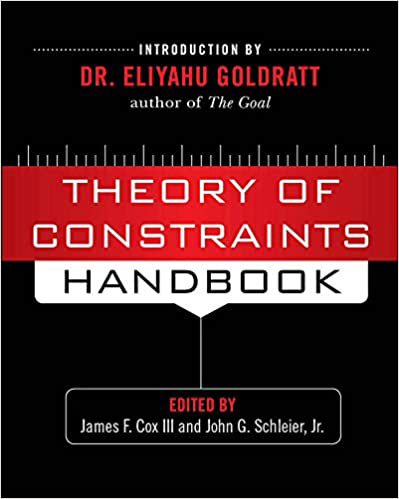
|
THE TOC BODY OF KNOWLEDGE
There is a real necessary condition for sustaining and spreading TOC, which is keeping the TOC Body of Knowledge (BOK) progress. That means having an effective way to encourage both consultants and practitioners to offer new knowledge that becomes part of the TOC BOK.
The TOC Body of Knowledge committee was formed to review, develop, and publish an up-to-date TOC body of knowledge. It was built to provide a relatively convenient and friendly way check any new approach, discuss its merits with the developers, and when confirmed as new knowledge put a paper in a special page within the TOCICO site.
There are two references which are recognized for the current TOC BOK: The Theory of Constraints Handbook and the TOCICO Dictionary.
|
|
|
TOC BOK PAPERS
At this time, there are now 18 TOC BOK papers which TOCICO has formally recognized as new TOC knowledge:
- Standing on the Shoulders of Giants (Four Concepts of Flow) by Dr Eli Goldratt
- The Six-Step Process for Standing on the Shoulders of Giants by Dr Lisa Anne Ferguson
- ProConCloud by Dr Alan Barnard
- Agile CCPM: Critical Chain for Software Development by Koichi Ujigawa and David Updegrove
- The TOC Pillars by Humberto Baptista
- Goldratt Six Questions by Eli Schragenheim
- Mystery Analysis by Yuji Kishira
- Unique Features of Government and How Governance Could be Assisted by the Theory of Constraints by Alfredo Mycue and Eli Schragenheim
- Cash Constraint and Cash Buffer by Ravi Gilani
- Systematic Learning from Significant Surprising Events by Eli Schragenheim
- Implications of the Theory of Constraints for Sales by Justin Roff-Marsh
- Using Throughput Economics to Make Better and Safer Business Decisions by Eli Schragenheim, Henry Camp and Rocco Surace
- The Origin of the Goal Tree by H. William (Bill) Dettmer
- Magic Druids by James Powell and Peter Cronin
- The Change Matrix: Corrected & Enhanced from 4 to 6 Boxes (CM2) by Richard Zultner
- Justice in Time
by Shany Azaria, Boaz Ronen, and Noam Shamir
- The Fundamental Structure of the Theory of Constraints - DRAFT by Eli Schragenheim and Dave Updegrove
- Conditional Reality Tree by Dr Abeer Youssef and Prof Vicky Mabin
|
|
|
WHAT IS NEW TOC KNOWLEDGE?
|
|
New knowledge might challenge some old or existing knowledge of TOC, and it may even challenge some of Dr. Goldratt’s work. Even though the TOC Handbook and TOCICO dictionary are recognized as current TOC knowledge, it doesn’t mean that their content shouldn’t be challenged. It could be that there are certain TOC practices that conflict with one another. While eventually it’s expected that all such clouds/clashes will evaporate, this shouldn’t prevent us from recognizing both approaches until the solution is found. New knowledge can be expanding part of the known TOC insights to new areas. It could be merging ideas that were generated outside of TOC with the TOC methodology, and it also could outline the boundaries of existing TOC practices.
|
|
|
WHAT IS THE PROCESS AND HOW TO SUBMIT NEW KNOWLEDGE?
|
|
The TOC BOK committee has created a more flexible open process for claims for new TOC Knowledge. It is important to note that the White Paper process will remain as it is. The TOC BOK new knowledge paper guidelines are an alternative to the more formalized white paper process.
Please use the following guidance in putting together your paper detailing your claim for new knowledge:
- Originality: Does the paper contain sufficient new TOC knowledge?
- Relationship to existing knowledge (literature, presentations, etc...): Does the paper acknowledge and build on or challenge relevant knowledge? Who are the relevant parties? Is any relevant work ignored?
- Methodology: Is the paper's argument built on an appropriate basis of theory, concepts, or other ideas? Are the flawed assumptions that set this new knowledge apart identified? Is the approach adopted appropriate and justified? This may include use of the TOC Thinking Processes.
- Results: Are the supporting results clearly presented and appropriately analyzed? Do the conclusions adequately tie the other elements of the paper together?
- Implications of new knowledge: How is the new knowledge used in practice?
- Quality of communication: Is the new knowledge clearly presented?
At least two members of the TOC BOK committee will review your paper and provide feedback using this guidance structure. Authors may also be invited to one of the monthly TOC BOK committee meetings to discuss the content. Once the new knowledge is accepted and any amendments have been made, the paper will be published, preferably with a supporting video if available.
Interested to submit? Please complete the form below.
|
|











